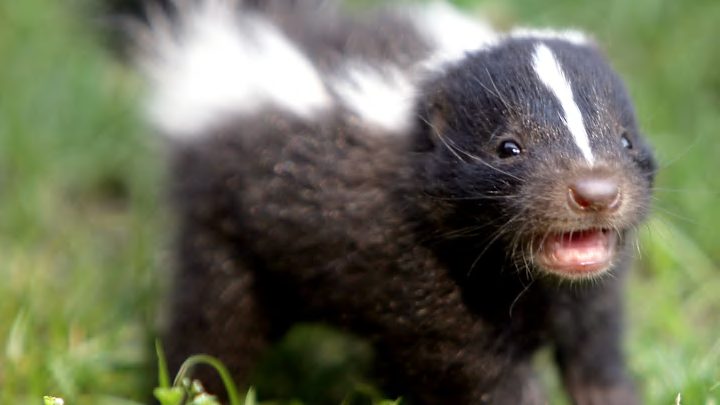We’ve already gathered up some barely-heard-of names for newborn animals, but there are even more lesser-known monikers. "Look at that little squeaker" may not be the most perfect thing to coo at a baby pigeon, but it’s accurate. Here are 10 more of the offbeat and uncommon references for baby animals.
- Kit // Baby Skunk
- Poult // Baby Turkey
- Chulengo // Baby Guanaco
- Pinkie // Baby Rat
- Peachick // Baby Peafowl
- Spat // Baby Oyster
- Nymph, Wriggler, Tumbler // Baby Mosquito
- Polliwog, Tadpole, Froglet // Baby Frog
- Elver // Baby Eel
- Squab, Squeaker // Baby Pigeon
Kit // Baby Skunk

Kits bear physical signs of what their fur patterns will look like when they’re full-grown adults. They have markings on their naked skin that will later be replaced by fur. It’s like a peek into the future. And yes, baby skunks have the ability to spray from birth, but their chemical defense mechanism isn’t as strong.
Poult // Baby Turkey

After hatching, baby turkeys take shelter under their mom’s wings. If they get separated, they let out a panic call. Multiple poults actually travel in a single-file line.
Chulengo // Baby Guanaco

Chulengos come from another barely-known animal: the guanaco, a South American-native animal from the camelid family. Even though they’re related to camels, they don’t have humps on their backs.
Pinkie // Baby Rat

Technically, a “pinkie” is a baby rat that is going to be used as food, but it’s a cute name. The name is frequently used by snake owners.
Peachick // Baby Peafowl

The U.S. has mostly blue (or Indian) peafowls; this type of bird has been raised in captivity for more than 2000 years. Peafowl is the all-encompasing term for what is generally known as a peacock. Peacock refers to a male peafowl and peahen refers to a female. A peafowl is only a peachick when it is younger than one year old.
Spat // Baby Oyster

Way before it’s possible to grow a pearl, a spat must grow into an oyster. Usually in the spring or the fall, adult pearl oysters will spawn into rich, nutrient loaded waters, and the oyster’s sperm will fertilize the eggs. It takes about one or two months for a spat to grow to a size visible to the naked eye.
Nymph, Wriggler, Tumbler // Baby Mosquito

A baby mosquito’s name isn’t related to Tumblr, the popular blogging website of the 2010s. Little tumblers (sometimes called “wrigglers” or “nymphs”) have occupied Earth for more than 210 million years, but their life expectancies are extremely low. Male mosquitoes live for less than a week and females can live up to a few months under ideal conditions.
Polliwog, Tadpole, Froglet // Baby Frog

There are three names for baby frogs, depending on which segment of the life cycle they’re in. After 21 days of being an embryo, a baby frog is called a “tadpole” (but really is called a “polliwog”) and at this point, has a long tail and lives in the water. It actually becomes a tadpole when it sprouts legs. As a froglet, the tadpole has almost matured into a full-grown adult that breathes with lungs, but still has a bit of a tail.
Elver // Baby Eel

The value of elvers has skyrocketed in recent years as the demand for them has spiked in Asia. In fact, in February 2013, out of 5000 applicants in Maine’s elver lottery, only four fishermen were given licenses to use hand-dip nets in the state’s elver fishery.
Squab, Squeaker // Baby Pigeon

Parent pigeons typically hide their young for a month after hatching, ensuring that they will be able to survive. As a result, it’s very rare to see a squab (or squeaker) because they’re almost fully grown by the time parents let them spread their wings.
Read More About Animals:
A version of this story originally ran in 2013; it has been updated for 2025.
